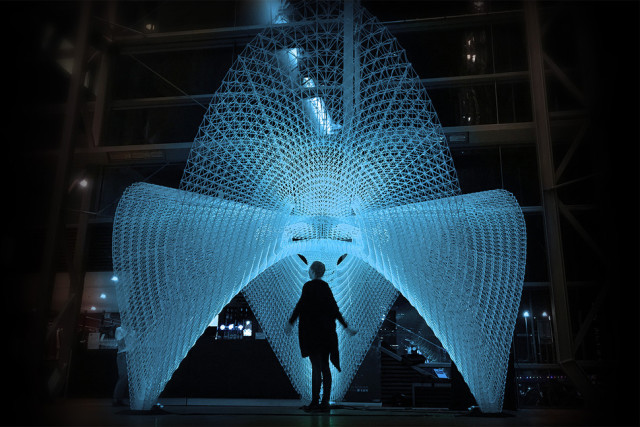
The nascent additive construction industry is slowly starting to take shape as an increasing number of start-ups appear on the scene with techniques for 3D printing large-scale structures.
The latest is a London-based company called Ai Build, which aims to make additive construction smarter and more accessible through the use of artificial intelligence and affordable materials.
As with many additive construction endeavors, Ai Build’s entry into the field begins with a 3D-printed pavilion. As an ornamental building, a pavilion is the perfect large, yet nonfunctional structure for demonstrating the possibilities of 3D-printed architecture, as there is no need to meet critical requirements for a building that might be used by people, as with an office or a home.
Unveiled at the GPU Technology Conference in Amsterdam at the end of September, the Daedalus Pavilion is a structure made from 48 different pieces 3Dprinted from Formfutura PLA filament over the course of three weeks. The structure, measuring approximately 16.4 ft(5m) wide by 16.4 ft (5m) deep by 14.8 ft(4.5 m) tall, was then shipped in pieces and assembled on site in just a matter of hours.
As beautiful as the initial structure may be, the Daedalus Pavilion is only the beginning for the start-up as Ai Build explores the use of large-scale 3D printing and computer vision for more advanced construction methods.
Large-Scale 3D Printing with Plastics
Cam received a bachelor’s degree in architecture from Istanbul Technical University in 2009 before going on to obtain a master’s from the Architectural Association Design Research Lab in 2012. Cam explained that, in pursuing architecture, it was often necessary to translate one’s designs into something that could be reasonably executed in the physical world using existing technology. Large-scale 3D printing, however, presented the opportunity to materialize even the most complex designs.
About one year ago, Cam founded Ai Build with his partners using their own funds. “Traditionally, 3D printing is used for smaller objects, mostly for prototyping and some medical applications, but it’s not very common in the construction industry, so we really want to make it a bit more accessible by developing hardware and software and making things easier for large-scale 3D printing,” Cam said. “When we started the company, the initial idea was that why don’t we find an easier way? Why don’t we transform construction in the 3D printing space so that we can design things more freely?”
Read more at ENGINEERING.com

